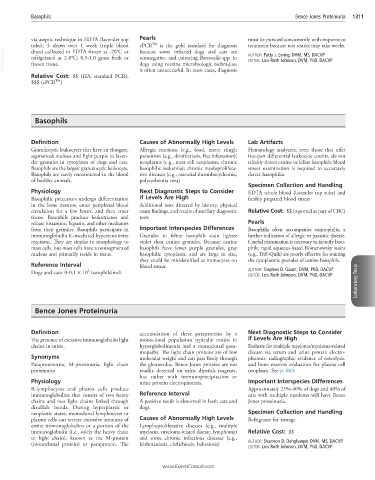Page 2592 - Cote clinical veterinary advisor dogs and cats 4th
P. 2592
Basophils Bence Jones Proteinuria 1311
via aseptic technique in EDTA (lavender top Pearls must be pursued concurrently with response to
TM
tube); 3 draws over 1 week (triple blood ePCR is the gold standard for diagnosis treatment because test results may take weeks.
VetBooks.ir refrigerated at 2-8°C; 0.5-1.0 gram fresh or seronegative, and culturing Bartonella spp. in AUTHOR: Patty J. Ewing, DVM, MS, DACVP
because some infected dogs and cats are
draw) collected in EDTA frozen at -20°C or
EDITOR: Lois Roth-Johnson, DVM, PhD, DACVP
dogs using routine microbiologic techniques
frozen tissue.
Relative Cost: $$ (IFA, standard PCR); is often unsuccessful. In most cases, diagnosis
TM
$$$ (ePCR )
Basophils
Definition Causes of Abnormally High Levels Lab Artifacts
Granulocytic leukocytes that have an elongate, Allergic reactions (e.g., food, insect sting); Hematology analyzers, even those that offer
segmented nucleus and light purple to laven- parasitism (e.g., dirofilariasis, flea infestation); five-part differential leukocyte counts, do not
der granules in cytoplasm of dogs and cats. neoplasms (e.g., mast cell neoplasms, chronic reliably detect canine or feline basophils; blood
Basophils are the largest granulocytic leukocyte. basophilic leukemia); chronic myeloprolifera- smear examination is required to accurately
Basophils are rarely encountered in the blood tive diseases (e.g., essential thrombocythemia, detect basophilia.
of healthy animals. polycythemia vera)
Specimen Collection and Handling
Physiology Next Diagnostic Steps to Consider EDTA whole blood (lavender top tube) and
Basophilic precursors undergo differentiation if Levels Are High freshly prepared blood smear
in the bone marrow, enter peripheral blood Additional tests directed by history, physical
circulation for a few hours, and then enter exam findings, and results of ancillary diagnostic Relative Cost: $$ (reported as part of CBC)
tissue. Basophils produce leukotrienes and tests
release histamine, heparin, and other mediators Pearls
from their granules. Basophils participate in Important Interspecies Differences Basophilia often accompanies eosinophilia, a
immunoglobulin E–mediated hypersensitivity Granules in feline basophils stain lighter further indication of allergic or parasitic disease.
reactions. They are similar in morphology to violet than canine granules. Because canine Careful examination is necessary to identify baso-
mast cells, but mast cells have a nonsegmented basophils have fewer purple granules, gray phils; rapid aqueous-based Romanowsky stains
nucleus and primarily reside in tissue. basophilic cytoplasm, and are large in size, (e.g., Diff-Quik) are poorly effective for staining
they could be misidentified as monocytes on the cytoplasmic granules of canine basophils.
Reference Interval blood smear.
Laboratory Tests
3
Dogs and cats: 0-0.1 × 10 basophils/mcL AUTHOR: Stephen D. Gaunt, DVM, PhD, DACVP
EDITOR: Lois Roth-Johnson, DVM, PhD, DACVP
Bence Jones Proteinuria
Definition accumulation of these paraproteins by a Next Diagnostic Steps to Consider
The presence of excessive immunoglobulin light monoclonal population typically results in if Levels Are High
chains in urine. hyperglobulinemia and a monoclonal gam- Evaluate for multiple myeloma/myeloma-related
mopathy. The light chain proteins are of low disease via serum and urine protein electro-
Synonyms molecular weight and can pass freely through phoresis, radiographic evidence of osteolysis,
Paraproteinuria, M-proteinuria, light chain the glomerulus. Bence Jones proteins are not and bone marrow evaluation for plasma cell
proteinuria readily detected on urine dipstick reagents, neoplasm. See p. 663.
but rather with immunoprecipitation or
Physiology urine protein electrophoresis. Important Interspecies Differences
B-lymphocytes and plasma cells produce Approximately 25%-40% of dogs and 40% of
immunoglobulins that consist of two heavy Reference Interval cats with multiple myeloma will have Bence
chains and two light chains linked through A positive result is abnormal in both cats and Jones proteinuria.
disulfide bonds. During hyperplastic or dogs.
neoplastic states, monoclonal lymphocytes or Specimen Collection and Handling
plasma cells can secrete excessive amounts of Causes of Abnormally High Levels Refrigerate for storage.
entire immunoglobulins or a portion of the Lymphoproliferative diseases (e.g., multiple
immunoglobulin (i.e., solely the heavy chain myeloma, myeloma-related disease, lymphoma) Relative Cost: $$
or light chain), known as the M-protein and some chronic infectious diseases (e.g.,
(monoclonal protein) or paraprotein. The leishmaniasis, ehrlichiosis, babesiosis) AUTHOR: Shannon D. Dehghanpir, DVM, MS, DACVP
EDITOR: Lois Roth-Johnson, DVM, PhD, DACVP
www.ExpertConsult.com

